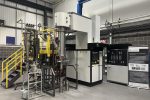
Metalysis scaling powder production with new Tekna 40 kW spheroidiser
3dprintingindustry.com
UK-based metal AM materials producer Metalysis has bolstered its capabilities by acquiring a 40 kW Tekna spheroidiser, aka Teksphero-40.Designed for the production of spherical powders, Teknas system caters to niche markets with high-value applications and supports the development of new alloys on a smaller scale. This step aligns with Metalysis strategy to scale up production of refractory alloys, such as tantalum and high-entropy alloys, while preparing to serve the high-temperature niobium market with materials like niobium C103 and FS85.Nitesh Shah, CEO of Metalysis, said, By controlling our spheroidisation processes, were not only reducing lead times and mitigating global supply chain risks, but also reinforcing our sustainable footprint. This is a pivotal moment for Metalysis as we strengthen our position in the critical materials supply chain now able to provide spheroidised powders in-house.The 40 kW Tekna spheroidiser, aka Teksphero-40. Photo via Metalysis.Improving powder processing with spheroidisationWith its patented Fray, Farthing and Chen (FFC) Cambridge process, Metalysis enables reduced metal oxides in the solid-state, bypassing traditional melting techniques.This novel approach delivers angular powders with specialized properties, meeting the demands of industries such as aerospace, clean energy, hypersonics, semiconductors, capacitors, and space exploration. Incorporating the spheroidiser, as per Metalysis, would enable the company to expand its portfolio by producing spherical powders, which retain the unique attributes required by global customers.Teknas Teksphero-40 spheroidiser enhances powder flowability, minimizes internal porosity, and achieves higher packing density. It also creates less friable powder and increases material purity, making it indispensable for applications like additive manufacturing, metal injection molding, spark plasma sintering, and hot isostatic pressing.Versatility is another key advantage, with the unit supporting a wide range of precursors, including dry powders, ceramics, reactive gases, and suspensions. Powder sizes of up to 500 m and feed rates of 510 kg/h ensure compatibility with both research and production-scale operations.Ease of use and safety features also define the Teksphero-40. A touch-screen interface with data logging simplifies operation, while easy-to-clean components support efficient batch processing. Technicians can become fully operational after minimal training, enabling quick adoption of the system.Compact dimensions measuring 4.6m in length, 3.8m in width, and 2.9m in height ensure seamless integration into standard facilities, requiring minimal utilities. Safety measures, including interlocks with alarms, EM shielding, and secure powder handling options, underline its suitability for high-demand industrial environments.Sustainability remains central to Metalysis operations. The FFC Cambridge process, combined with spheroidisation, allows precise tailoring of particle sizes while minimizing waste.Unlike conventional atomization methods, this approach generates negligible scrap powder and consumes less energy. Vertical integration of spheroidisation further reduces global supply chain risks and eliminates the need for long-distance material transport, contributing to a significantly smaller environmental footprint.Titanium parts and powder produced by Metalysis. Photo via Metalysis Metal powder production in 3D printingAway from Metalysis, other entities brought forward their unique offerings for streamlined high-quality metal powder production.For instance, Warsaw-based 3D printing service bureau 3D Lab introduced the ATO Suite at Formnext 2024, targeting improved control over metal powder production. Designed for efficiency and sustainability, the suite facilitates high-quality spherical metal powder production from diverse feedstocks, supporting advanced applications such as additive manufacturing.Its modular components, including the ATO Lab Plus and ATO Noble, address workflows from feedstock preparation to powder refinement. Having integrated ultrasonic atomization and induction melting technologies, the suite enhances particle size control, flowability, and material recovery. These features cater to industries requiring precise powder specifications while emphasizing waste reduction and closed-loop manufacturing processes.Back in 2022, Indian Institute of Science (IISc) researchers developed an abrasion-based method for producing metal powders for use in 3D printing. Offering an alternative to atomization, the widely used but resource-intensive technique, their approach addressed challenges like low material yield, high costs, and restricted metal compatibility.By refining metal grinding processes, the team created steel powders that matched the quality of atomized counterparts while significantly reducing production costs. With scalable potential, the method opened opportunities for advanced applications in aerospace and biomedical manufacturing, making metal powders more affordable and accessible for high-performance industries.Who won the 20243D Printing Industry Awards?All the news fromFormnext 2024.To stay up to date with the latest 3D printing news, dont forget to subscribe to the 3D Printing Industry newsletter or follow us on Twitter, or like our page on Facebook.While youre here, why not subscribe to our Youtube channel? Featuring discussion, debriefs, video shorts, and webinar replays.Featured image shows the 40 kW Tekna spheroidiser, aka Teksphero-40. Photo via Metalysis.
0 Comments
·0 Shares
·154 Views


